|
PLEASE NOTE - A STRONGER RECOMMENDATION
OF KT88/120 OVER EL34

NOW MARK 2 & MK4 TUNG-SOL KT120 OPTION AVAILABLE
Price Mk2 is $1100 incl. GST plus cost
stock Yaqin MC-100B
Price Mk4 is $2200 incl. GSTplus cost
stock Yaqin MC-100B
Additional for KT120
option at cost only. Please email me.
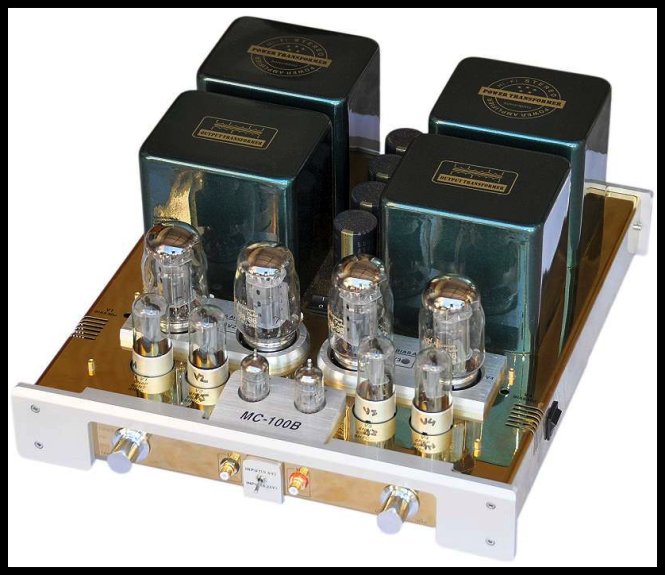
Please Note: Works Both as Integrated
& Power Amplifier
CONCEPTUAL SCHEMATIC:
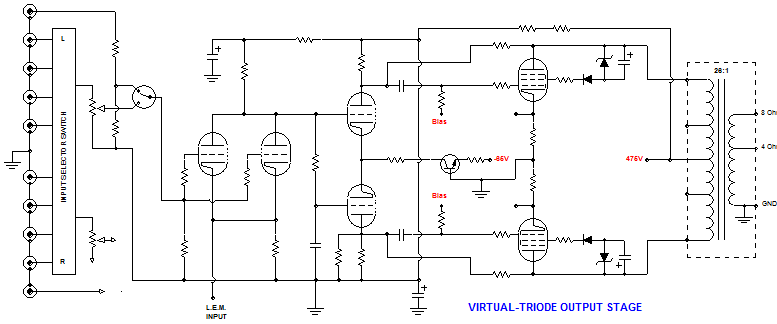
Above Mk2 Schematic. Mk4 Schematic is more complex and superior power
supply.
EL34 Now Available as Power Amplifier
Only - See Below

Projected Price is based on $1100 plus projected
cost of import. Please email me.
NICE ONLINE REVIEW by
Digital Audio Review
User
Review
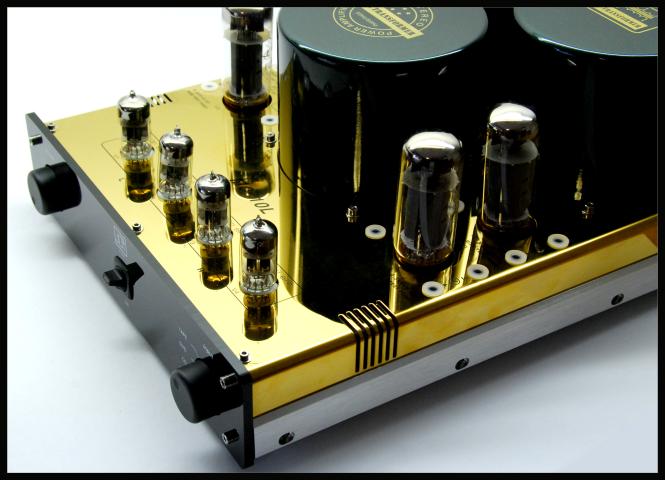
"JLTi" EL34
Power Amplifier Only - Save $100
Featuring "Virtual
Triode Mode Operation" & "Induced Permeability" and more clever
technology.
Hello, my name
is Joe Rasmussen and I have an interesting story to tell. I am not known
as a person disposed towards hyperbole, but I will start with a startling
exclamation:
The Plan: To take a mass-produced OEM type Chinese made amplifier with decent
basic performance and reasonable components such as good transformers with
good bandwidth. The Chinese can now do that better than anybody else and
they can turn these out at a cost we cannot compete. But the sonic
performance is generally less than desirable compared to the very best.
But we are going to change that.
Rebuilding: We
can rebuild key aspects of a basic Chinese design using some leading edge
technology. Crucial components are changed (no, not the usual parts
substitution that everybody else does) and a special "Induced
Permeability" module super-charges the output transformers, the output
tubes are wired in "Virtual Triode Mode", and much more. We
are talking real 2010+ tube technology here.
Input
Circuitry:
Now employs Constant Current Source technology and direct coupling
minimises the need for coupling capacitors, only two per channel.
Deceptively simple and yet lacking nothing in performance.
Output Stage:
Virtual Triode Mode
- adds amazing dynamic and life to the music, for the first time we are
able to make Pentodes behave as proper Triodes. The problem, being the Screen
electrode, is 'shadowed' in relation to the Anode and is thus hidden,
making the tube perform as if the Screen electrode wasn't there. The
result is nothing short of a revelation. Musical sounds will jump from
your speakers like never before - and prove once and for all the dynamic
and musical superiority of tubes over solid-state and transistors. The
critical impedance match between the anodes of the output tube and the
primary winding of the output transformer is now far more dynamically
stable. It is not appreciated by many designers that this interface is
actually a high-pass filter that needs to be kept at as low a frequency as
possible and then kept there under transient conditions. The leading edge
research done by Menno Vanderveen (www.mennovanderveen.nl) has clarified
this condition and we can now take advantage.

(Wish to thank Bill Perkins
for his invaluable contribution.)
No Negative
FeedBack:
As new type of Triode stage is far more dynamically stable and linear,
negative feedback can be completely eschewed. Eliminated! This also means
that the amplifier is totally stable and completely unflappable. Loop
feedback around a bandpass device (which is what a transformer is) leads
to time smear that can cycle through the loop many times. It may sound
like it is tightening up the bass, but it ends up sounding flatter and the
magic that is the midrange becomes subtly dried out. Feedback is not the
answer and once the answer has been found, then feedback is not needed.
Induced
Permeability:
This technology was in fact patented during the Second World War and
then subsequently forgotten. What a pity. According to our foremost
researcher on tube transformers, Menno Vanderveen (from the Netherlands
and designer for companies like Plitron), the major shortcoming of tube
output transformers is the lack of Permeability at low signal levels,
leading to lack of resolution in a similar way to DACs (Digital to Analog
Converters) suffer from at low levels (this fact will stun quite a few pro
tube aficionados). High Permeability cores can be used to offset the
problem, but these saturate at about half the power and the so-called
amorphous cores are very expensive indeed. A 50 Watt transformer will be
derated to 25 Watts or it distorts badly.
THE
SOLUTION:
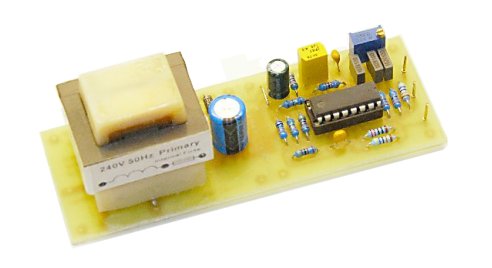
The solution
is highly imaginative; make use an unused portion of the transformers
bandwidth (very high frequencies) and then excite the transformer at a
specific level that does no damage to the speaker and yet is high enough
to stop the Permeability sliding to dangerously low levels below that. We
also do not suffer from saturation and poor power performance as the
transformer is not derated. The module fitted is called an L.E.M.,
Linearity Enhancement Module, and the result is to induce
Permeability so it never drops below our defined level.
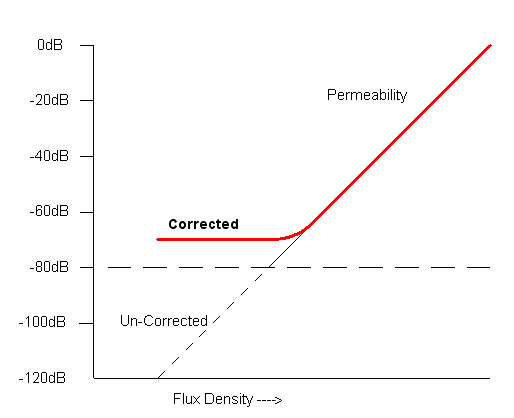
The result is
superior definition and a marriage made in heaven when combined with Super
Linear Triode Mode.
This
combination, the Super Linear Triode and the L.E.M. is the crux of the
story here, taking a modest tube amplifier and make it perform like little
else out there does.
New Input
Selector:
Cheap rotary switch is replaced with higher quality silver contact type.
New Volume
Control:
The
silver-carbon "JLTi" pot is simply the best sounding potentiometer we know
of. Virtually all pots sounds excessively coloured (plummy mid-bass is
common and shut-in top octaves and less overall resolution) whereas the
JLTi pot sound quality is close to high quality switched attenuators but
at a fraction of the price.
New Input and
Inter-Stage Wiring: Single core silver impregnated copper from OK Wire Company in the
UK. This has also been cryoed.
New Front
Panel:
The original is not compatible with the JLTi pot (short shaft and needs
spline type knob) and thus a new one is fitted. This now sports the JLTi
logo.
How does one
describe the sound?
In many ways it is similar to what might be
described as a Single-Ended sound, also called S-E. If that is the kind of
sound you are into, then this is the Push-Pull amplifier that will change
your mind about P-P amps. It has none of the downsides usually associated
with P-P, but far more dynamic and has much greater sonic impact
(single-ended has asymmetrical rise time that blunts transients but
regular P-P sound less pure and coarse sounding - but this is not the case
here).
While only
rated 20 Watts per channel, many have commented that it sounds far more
powerful than that. When compared with the Audio Research D125, the owner
of the AR was surprised to hear it was only 20 Watts as he had expected
60-70 Watts (the AR will soon be on sale on eBay). It is clear that in
sound systems that lacks genuine dynamics, listeners simply feel the need
to turn up the volume to compensate for this lack. Is this is why we see
300 Watt amplifiers in cars and young drivers exposing themselves to
hugely loud music?
But dynamics
and loudness is not the same thing. Here we have an amplifier that uses
technology that enables true dynamics and amazing impact at reasonable and
realistic volume without the need to turn the volume up any further. For
those limited to late evening low level listening, "this amp is a dream
come true" (Mariusz Mugaj, Perth, WA). Only when you have heard this
quality does it really become comprehensible. But in reality this ought
not to surprise us as the sounds we hear in real life are just like that.
As we walk
through the day we don't feel we need to turn up some imaginary volume
control, do we? But when we get to a sound system we have this need to
turn it up so far that we cannot hear someone right next to us speak? Yet
when we go to a concert where acoustic instruments are played, and the
sense of full emotional impact is there in abundance, and if our friend
next to us starts to talk and he is clearly audible, we realise that the
impact of what we hear is not entirely tied to the loudness we perceive.
Yes, realistic volume and no more. The music will do the rest for us!
But we have
not covered the majestic quality this amplifier has in portraying
realistic images and full bodied sound and capturing the beautiful colours
of real musical instruments. This is indeed a music lover's amplifier and
not a "Hi-Fi" amplifier. The sheer "body" (or solidity of sound) it can
produce will stun you, especially, but not uniquely, on voices, the sheer
physical presence of Diana Krall (I'm less a Norah Jones fan, but will
prove the same point) voice will say much more than any words here.
The top end is
extraordinary and unravels much intricate details previously not heard.
Most other amplifiers, regardless of cost and whether tube or solid-state,
sounds positively coarse. Curiously, while revealing more details in the
treble it is also much less bright sounding because it avoids the
coarseness and instead replaces it with a remarkable smoothness, silkiness
and exquisite air.
I will only be
too pleased to demonstrate the amplifier, just call and make arrangements
if you find yourself in the Sydney area. It is a real pleasure to be given
an opportunity to play it in a very good system and hear comments like
"amazing" and "chalk and cheese" and know that you are providing an
experience that they will not easily forget. Not everything in life is
about dollars.
Bring some CDs
and/or SACDs that you are familiar with. I am sure that you will agree
that this shows we are at the threshold of a greater appreciation of what
is really climbing the mountain that is electronically reproducing the
sound of real music. In the home, is this not the ultimate challenge for a
music lover?
Joe
Rasmussen
Custom Analogue Audio
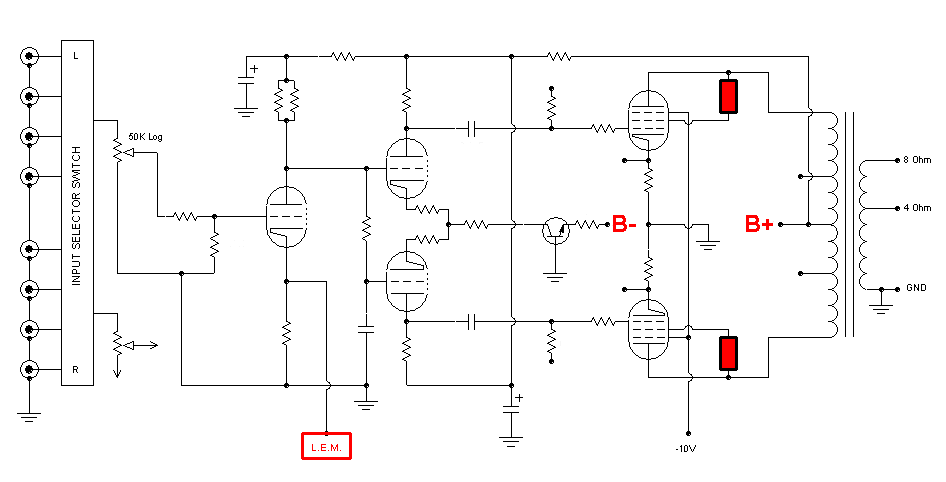
I
have had the amplifier now for 3 weeks in my system, build quality is nice
and the Chinese have got that right. The glow from the tubes at night time
is the best visual feature that only a valve amp can deliver. It also runs
hot once its warmed up, as would one expect from a valve amplifier.
What is more important than the looks of the amplifier, how it sounds!!!
This is where the JLTi shows its true dynamic and musical Nirvana. Never
in my wildest dreams I thought that 20 watts would deliver dynamics the
way this tube amp does. Please note that I don't listen to it until 2
hours of warming up as it becomes warmer and more full bodied after this
time than when it is first switched on.
There is no need to turn the volume up, the musicality comes so
effortlessly it is totally engaging and free from noise and grain or
harshness. Joe promised this dynamic effortlessness and he did not
exaggerate one bit. I am running in my system 86db speakers (Lenehan ML-1
Signature @ AUD $5000), so they are not highly efficient, yet no problem
with getting loud levels with clear and engaging sound from 20 watts. (Are
you sure it's only 20 watts, Joe? I think you should measure it again).
The bottom end has extension and body of a more powerful solid state
amplifier, but it never sounds dry. The midrange is like sweet honey
coming from my speakers. I have heard a lot of amplifiers in my system
some as much as $10,000 but nothing as engaging as the JLTi EL34. The
music just seems to flow without anything getting in the way. Joe said
this was more like the characteristic of a Single-Ended Triode amplifier,
that ability to let the music speak for itself and then get out of the
way. Three things come to mind, texture, harmonic beauty and
smoothness!
I was so impressed with the amplifier that I took it over to see a fellow
audiophile, Richard, who is an ex Vice President of Audiophile Society of
Western Australia. We ran the JLTi EL34 with his PROAC 3.5 Reference
Speakers for six hours. The JLTi had better bottom end, more low end
resolution and extension than his expensive Audio Research amp. Midrange
was sweeter and top end less grainy. Soundstage and imaging is also right
up there. Guess what? Richard now wants a JLTi EL34 configured as a power
amp and Joe said he is working on it.
Value for money? In my opinion, it just takes on another meaning. Not
often does a product such as the JLTi EL34 makes it to the listening room
of an audiophile like me and then gets a chance to audition it against a
much more expensive product like Richard's Audio Research, but I was lucky
to have the chance. IT is a shame that others don't have the same
opportunity to make this comparison as this is an audiophile product with
a price well below what one would expect to pay. For the audiophile or
music lover that does get an audition, they will know what I mean.
MARIO
ROCKINGHAM WESTERN AUSTRALIA
0403714667..
|